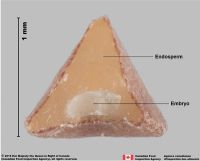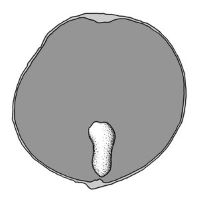Content is from Kirkbride et al. 2006Kirkbride et al. 2006:
Kirkbride JH, Jr, Gunn CR, and Dallwitz MJ. 2006. Family guide for fruits and seeds, vers. 1.0. Accessed September 2020-January 2022. URL: https://nt.ars-grin.gov/seedsfruits/keys/frsdfam/index.cfm ., without modification.
Updates are forthcoming.
Fruits: Pistil(s) 1 to more than 21; many. Fruit pericarpium; simplesimple:
fruit formed from a single flower with one pistil, solitary carpel or several fused carpels
, or schizocarpschizocarp:
usually dry fruit splitting between two or more locules to form distinct, indehiscent, usually one seeded segments; fruit derived from a single, superior or inferior, compound ovary; compare to mericarp , or compound; capsulecapsule:
, or compound; capsulecapsule:
a dry, dehiscent fruit derived from a compound ovary (not Spjut); baccarium (Spjut Fig. 12C-D & "partial partial:
(not Spjut); baccarium (Spjut Fig. 12C-D & "partial partial:
(of embryo) embryo occupies over one-quarter of the seed interior but less than full, with some endosperm present. Partial embryo size is common in families with spatulate, linear, and curved embryo shapes. ly united carpels separating into 1-seeded, fleshyfleshy:
ly united carpels separating into 1-seeded, fleshyfleshy:
texture—fairly firm and dense, juicy or at least moist, and easily cut
achenes" 5 families: Apocynaceae, Oleaceae, Phytolaccaceae, Sapindaceae, Saururaceae, Tropoaeolaceae); capsiconum (Spjut Fig. 16A-B & 5 families: Cunoniaceae, Hamamelidaceae, Myrtaceae, Salicaceae, Saururaceae); without persistent central column; with styles(s); at apexapex:
the point farthest from the point of attachment, or the "tip" of an organ ; not within accessory organ(s); 1-seeded (to few); 1-seeded (to few); with 3–5-carpellate; with carpels separate (at maturity); with carpels separating at maturity; with carpels not radiating at maturity; without sterilesterile:
; not within accessory organ(s); 1-seeded (to few); 1-seeded (to few); with 3–5-carpellate; with carpels separate (at maturity); with carpels separating at maturity; with carpels not radiating at maturity; without sterilesterile:
lacking male and/or female reproductive parts; also, not producing fruit or seed
 carpels; not sulcatesulcate:
carpels; not sulcatesulcate:
surface relief—having one or more elongate, relatively narrow and shallow depressions or grooves ; apexapex:
; apexapex:
the point farthest from the point of attachment, or the "tip" of an organ not beaked; dehiscentdehiscent:
not beaked; dehiscentdehiscent:
(v. dehisce) splitting open at maturity to release contents (of a fruit) , or indehiscentindehiscent:
, or indehiscentindehiscent:
not opening on its own, as in a fruit
 (Sauurus). Dehiscentdehiscent:
(Sauurus). Dehiscentdehiscent:
(v. dehisce) splitting open at maturity to release contents (of a fruit) unit seed(s), or endocarp(s) (Golberg's coccicoccus:
unit seed(s), or endocarp(s) (Golberg's coccicoccus:
fruitlets, derived from a schizocarpous gynoecium, opening along their ventral sutures and sometimes the dorsal sutures as a result of their separation from one another or from a central axis (Spjut 1994, slight modification)
). Dehiscentdehiscent:
(v. dehisce) splitting open at maturity to release contents (of a fruit) at apexapex:
at apexapex:
the point farthest from the point of attachment, or the "tip" of an organ ; and shedding seeds; without replumreplum:
; and shedding seeds; without replumreplum:
the rim, formed by the persistent placentas, and connected by a false septum in Brassicaceae fruits. The fruit valves are attached to this rim and separate from it in dehiscent fruits.
. Epicarpepicarp:
outer layer of fruit wall or pericarp, if divided into layers; note here used synonymously with exocarp durable; glabrousglabrous:
durable; glabrousglabrous:
without hairs
; with armature; with warts; with armature glochidiate, or without armature glochidiate; not smooth; warted, or wrinkledwrinkled:
surface relief—shallow, irregular folds and furrows covering the surface; appearing overall though crumpled and then spread out ; without wing(s); without apicalapical:
; without wing(s); without apicalapical:
at or pertaining to the end of the seed or fruit distal from its point of attachment (i.e., base)
respiratory hole. Mesocarpmesocarp:
the middle layer of the pericarp, if divided into layers absent. Endocarpendocarp:
absent. Endocarpendocarp:
the inner layer of the pericarp, if divided into layers present, or absent; not separating from exocarpexocarp:
present, or absent; not separating from exocarpexocarp:
outer layer of fruit wall or pericarp, if divided into layers; note here used synonymously with epicarp ; thinthin:
; thinthin:
having or being of relatively little depth
; not splitting into 1-seeded pyrenes; without operculumoperculum:
a dehiscent cap (or lid) of a seed or fruit that opens during germination or dehiscence
 ; without secretory cavities; without longitudinallongitudinal:
; without secretory cavities; without longitudinallongitudinal:
of or relating to length or the lengthwise dimension
ridges. Funiculusfuniculus:
(alt. funicle) stalk connecting the ovule (later seed) to the ovary (later fruit) placenta short; short without seed bearing hooks (retinacula); not persisting in fruit after seed shed.
short; short without seed bearing hooks (retinacula); not persisting in fruit after seed shed.
Seeds: Arilaril:
(broad sense) appendicular structure that wholly or partly envelops a seed and is produced from or a modification of the funicle, raphe, or outer integument; usually fleshy or pulpy, sometimes spongy or tufted-capillate, often brightly colored absent. Seed larger than minute; less than 1 mm long to 1 to less than 5 mm long; 1–2.5 mm long; circularcircular:
absent. Seed larger than minute; less than 1 mm long to 1 to less than 5 mm long; 1–2.5 mm long; circularcircular:
(of embryo) linear embryo is curved into an "O" shape , or ovateovate:
, or ovateovate:
2D shape—egg-shaped in outline, widest point is towards one end of the organ, the other end tapers gradually, attachment at or near the broad end (compare obovate, ovoid) (sub); not bowl shaped; not nutlike; without winglike beakbeak:
(sub); not bowl shaped; not nutlike; without winglike beakbeak:
a usually firm, terminal appendage, sometimes tapered ; without caudatecaudate:
; without caudatecaudate:
tapering to a long, tail-like appendage appendage(s); at maturity with food reserves; with endospermendosperm:
appendage(s); at maturity with food reserves; with endospermendosperm:
nutritive starch- and oil-containing tissue present in many seeds , or perispermperisperm:
, or perispermperisperm:
seed nutritive tissue comparable to the endosperm, but derived from the nucellus (maternal tissue)
; without canavanine. Sarcotestasarcotesta:
pulpy or fleshy outer layer of the seed coat, simulates aril absent. Testatesta:
absent. Testatesta:
seed coat
 present; without markedly different marginalmarginal:
present; without markedly different marginalmarginal:
at, on, or close to the margin or border
tissue; without fleshyfleshy:
texture—fairly firm and dense, juicy or at least moist, and easily cut
or leatheryleathery:
texture—moderately thick, tough, and very pliable
layer over hard layer; tight; surface unsmooth; surface with discreet raised features, or merged raised features; surface verrucoseverrucose:
surface relief—warty, covered with wart-like projections
; surface reticulatereticulate:
surface relief—netted, raised walls or concave grooves forming a net-like surface pattern with flat, concave, or convex interspaces ; without crease or line separating cotyledons from hypocotyl-radicle; without notch along margin where cotyledons from hypocotyl-radicle tip approach each other; without glands; without bristles; glabrousglabrous:
; without crease or line separating cotyledons from hypocotyl-radicle; without notch along margin where cotyledons from hypocotyl-radicle tip approach each other; without glands; without bristles; glabrousglabrous:
without hairs
; without wings; without collar; without operculumoperculum:
a dehiscent cap (or lid) of a seed or fruit that opens during germination or dehiscence
 ; colored; monochrome; brown (all shades); thinthin:
; colored; monochrome; brown (all shades); thinthin:
having or being of relatively little depth
, or coriaceouscoriaceous:
texture—leathery
, or thickthick:
having or being of relatively great depth
; not becoming mucilaginousmucilaginous:
resembling mucilage; moist and sticky
when wetted; surrounding food reserve. Endospermendosperm:
nutritive starch- and oil-containing tissue present in many seeds development cellular, or helobial; scant. Perispermperisperm:
development cellular, or helobial; scant. Perispermperisperm:
seed nutritive tissue comparable to the endosperm, but derived from the nucellus (maternal tissue)
copious; mealymealy:
loose, dry, and disintegrating in finely granular
pieces like meal or flour
; with starch; with starch composed of clustered grains; opaqueopaque:
not transmitting light
. Embryo differentiated from food reserve; rudimentaryrudimentary:
(of embryo) embryo is small and fills less than a quarter of the seed and can be variable in shapes, such as linear, spatulate, or oval ; 1 per seed; partially filling testatesta:
; 1 per seed; partially filling testatesta:
seed coat
 (with food reserve); 0.1 times the length of food reserve; at one end of seed not extending into a depression or cup; lenticularlenticular:
(with food reserve); 0.1 times the length of food reserve; at one end of seed not extending into a depression or cup; lenticularlenticular:
3D shape—lens-shaped; biconvex ; straight; transversetransverse:
; straight; transversetransverse:
lying, situated, or placed across
to seed length; capping one end of perispermperisperm:
seed nutritive tissue comparable to the endosperm, but derived from the nucellus (maternal tissue)
; without coleorhiza; without simmondsin; without stomata; not green; acotyledonous. Hypocotyl-radicle undeveloped.
General distribution: New World and Old World.
Detailed distribution: North America, Middle America, Asia Major, and Asia Southeastern.
General references: Corner, E.J.H. 1976. The seeds of Dicots, esp. vol. 2. Cambridge University Press, New York, Cronquist, A. 1981. An integrated system of classification of flowering plants, 1,262 p. Columbia University Press, New York, Engler, A. & K. Prantl. 1924 and onward. Die Natürlichen Pflanzenfamilimien. W. Engelman, Leipzig, Goldberg, A. 1986 (dicots) & 1989 (monocots). Classification, evolution, and phylogeny of the familes of Dicotyledons. Smithsonian Contr. Bot. 58 for dicots (314 pp.) & 71 for monocots (74 pp.). [Goldberg's illustrations are reproduced from older publications and these should be consulted], Gunn, C.R., J.H. Wiersema, C.A. Ritchie, & J.H. Kirkbride, Jr. 1992 & amendments. Families and genera of Spermatophytes recognized by the Agricultural Research Service. Techn. Bull. U.S.D.A. 1796:1–500, LeMaout, E. & J. Decaisne. 1876. A general system of botany, 1,065 p. Longmans, Green, & Co., London, Mabberley, D.J. 1987. The plant-book, 706 p. Cambridge University Press, Cambridge, Martin, A.C. 1946. The comparative internal morphology of seeds. Amer. Midl. Naturalist 36:513–660, Spjut, R.W. 1994. A systematic treatment of fruit types. Mem. New York Bot. Gard. 70:1–182, and Wood, C.E., Jr. 1974. A student's atlas of flowering plants: Some dicotyledons of eastern North America, 120 pp. Harper & Row, New York.